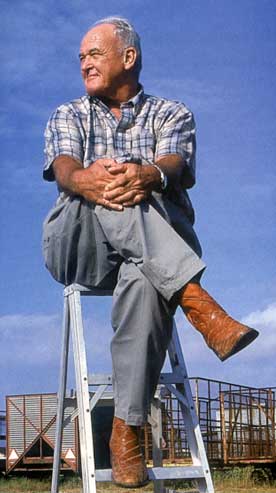Bobby Morrow by Mike Shropshire

Bobby Morrow on his cotton farm near San Benito
Morrow, who was raised on his family's farm near San Benito,
arrived on the campus of Abilene (Texas) Christian College in 1954.
The Wildcats' track coach, Oliver Jackson, in effect told Morrow that
if he wanted to attend a party school, go to Holy Cross; if he wanted
to win footraces, come to Abilene. Jackson had a plan. His intent was
to assemble a team of sprinters who could outrun the West Texas wind.
If they could do that, then they could outrun the world. In Morrow,
he found his main man.
"Bobby had a fluidity of motion like nothing I'd
ever seen," says the 80-year-old Jackson, who lives in Abilene.
"He could run a 220 with a root beer float on his head and never
spill a drop. I made an adjustment to his start when Bobby was a freshman.
After that, my only advice to him was to change his major from ag sciences
to speech, because he'd be destined to make a bunch of them."
By Morrow's sophomore year, he had tied world records
in the 100- and 200- meter dashes (10.2 and 20.6 seconds, respectively)
and anchored Abilene Christian relay teams to another world mark in
the 4 x 220. Still, track and field purists from the West Coast were
skeptical of Morrow's skill and suspicious of the wind gauges used at
meets in Texas. The San Benito Bullet? Sober up.
The doubt disappeared after the June 1956 U.S. Olympic
Trials at the Los Angeles Coliseum where Morrow won the 100 and 200
meters. By then, everyone realized it made no difference whether the
man in the next lane was from Baylor or Belgrade-he had no chance of
outrunning Morrow. Morrow's only bona fide rival was Duke's Dave Sime,
destiny's victim, who beat Morrow in the 100-yard dash at the Drake
Relays in April 1956 but was injured at the trials.
"I was standing near the finish line for the 100-meter
finals in Melbourne," says Bob Richards, who won the gold medal
in the pole vault at the 1956 Games. "The track was terrible. Loose,
like sawdust, and Bobby was kicking cinders 10 feet into the air behind
him. On a modern surface, there is no doubt in my mind that Bobby would
have run an eight-something 100 meters. He was the greatest sprinter
I ever saw."
At slightly more than 6 feet, Morrow was tall for a sprinter,
but his legs were thick. Stylistically Morrow was a symphonic convergence
of many moving parts, his stride offering the illusion of a man floating
an inch or so above the cinder fairway. "Oh, he looked so relaxed,
so graceful, like when he was chasing rabbits back on the farm. That
was Bobby's trademark," says Jo Ann Richey, Morrow's former wife.
|